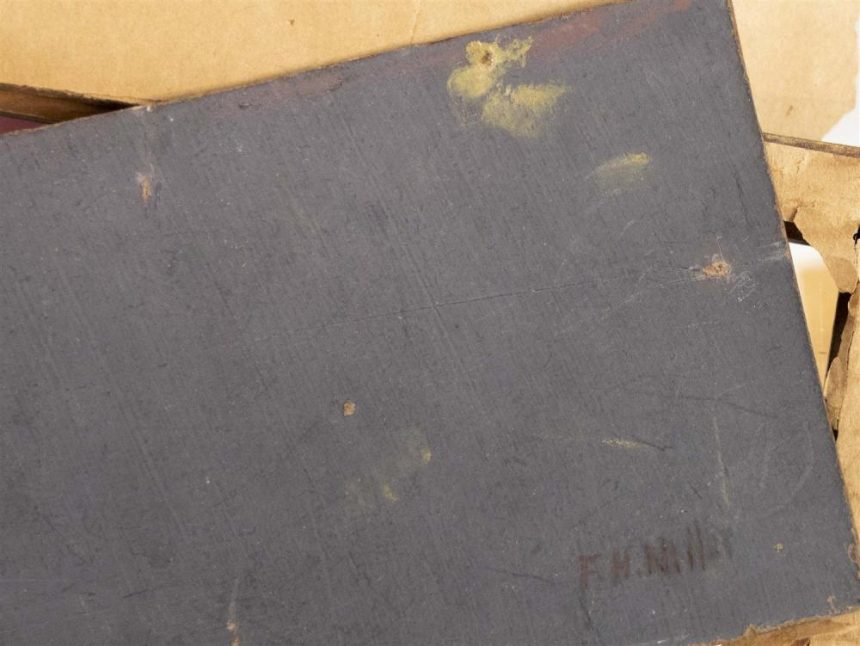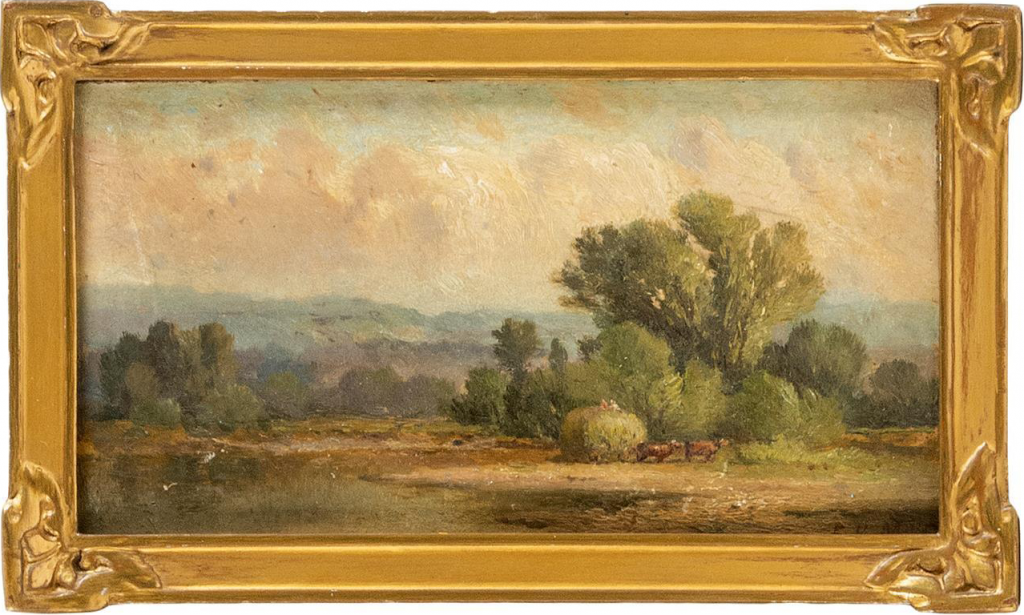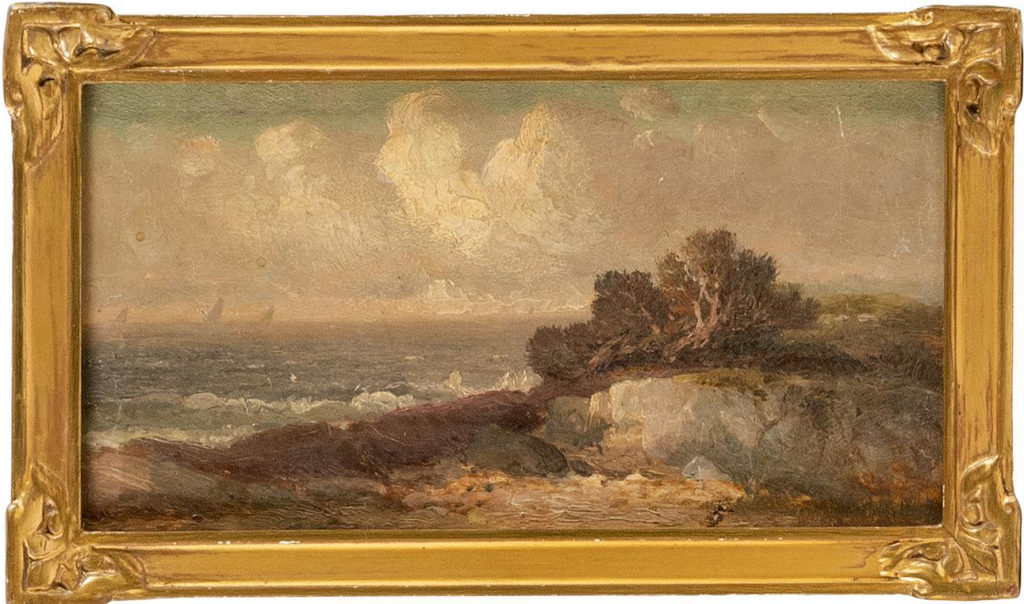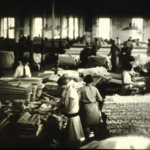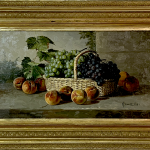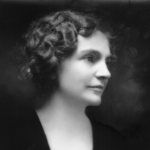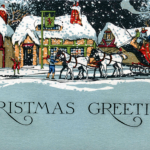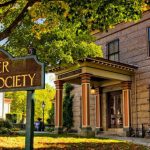It was a few weeks ago, while scanning the various lots of an online auction catalogue, that I noticed a pair of paintings. The artist’s hand certainly looked familiar – unmistakable, really, and especially evident in the masses of clouds, heightened in light and shadow, strewn across an infinity of sky. He was a master of clouds.
Amazing, the manner in which the artist managed to depict huge vistas on diminutive panels. I have always been drawn to small paintings – there is something uniquely charming about them, a Lilliputian world realistically captured – and these were stellar examples. The artist, whose life and work I find of particular interest, was highly adept at small paintings, though he most often worked on a larger scale.
The paintings were captivating little gems and, despite the heavy layer of surface grime and discolored varnish, one could easily be transfixed and become lost in the expansive – albeit tiny – depictions of land and sea.
Few people take the time to actually look at paintings – to clear the mind of all else in order to study and observe – and these two works were certainly worthy of the attention. A pleasure, that, to discover what the artist saw – or imagined – and captured when taking brush to oil, to panel, well over one century before.
Great stuff!
In one painting, harnessed oxen stand at the ready to pull a heavily laden hay wain, nestled atop which are two figures, resting, perhaps, at the end of a long day of haying; a third figure is at the rear wheel, with bent posture indicating a spoke or hub check before departure. They are no more than dabs of paint, yet so expertly applied as to leave little doubt of their presence, and importance, in the composition. In the left foreground, a lake or pond; in the distant background, rolling hills; and in the middle distance, pasture and wood. The whole plays out beneath a vast sky, dominated by masses of frothy clouds.
The scent of it all, carried on a steady breeze perfumed by glade and hay and fresh animal dung wafted over clear, cool water, can easily be imagined – if one observes.
The other depicts the edge of a seemingly vast sea, viewed from the banks of a rugged, wave-kissed shore; a small stand of misshapen, windswept trees – their trunks distorted by the relentless onslaught – cling to life, rooted in a thin deposit of soil carpeted over craggy rock. Three boats, in full sail, can be seen on the horizon, beneath a heavily clouded sky.
The crisp, salt-misted air, and the song of wave playing on rocks is brilliantly conjured – especially so if, again, one takes the time to observe.
They were beautiful little paintings.
A very good sign, by the way – the presence of heavy surface grime and discolored varnish.
Why?
Because they were in original, untouched condition, an indication that they had possibly been in the same collection for some time and were new to the market.
What was the provenance, I wondered? Clearly, there is a backstory … always is.
The auction listing:
AMERICAN SCHOOL
Late 19th Century
Pair of Landscapes
One signed lower right “F.H. Miller,” possibly Franklin Harrison Miller (Massachusetts, 1843-1911).
Oils on artist board, 4” x 7.5”. Framed 5” x 8.5”.
Estimate: $300 -$500
I enlarged the images:
The declaration “Possibly Franklin Harrison Miller” immediately translated in my mind to “definitely” – without a doubt – and, likewise, “Massachusetts” was preceded, mentally, by a city … Fall River. Stylistically, I would date them to the 1880s. The signature was undoubtedly his.
My immediate thought: These should be in the FRHS collection.
And fortunately, there was a generous benefactor – anonymous, for the moment – willing to help the museum acquire them. It would not have been possible any other way; for that, the donor has my sincerest thanks. I have often asked for their assistance, and rarely have they declined.
Franklin Harrison Miller was a hugely talented artist, yet surprisingly little has been written about him and, although prolific, his works rarely appear in the market; he has yet to receive the recognition he deserves.
A bio in brief:
Born in Fall River in 1843, Franklin was the son of Southard Harrison Miller (1810-1895), a prominent Fall River contractor and leading citizen, and Esther G. Miller, née Peckham (1813-1892); he breathed his first, and last, in the family home on Second Street.
Of his youth and formal education little is known; it was clearly a privileged upbringing, and he counted among his friends the scion of the city’s oldest families. Among his closest friends were: Bradford Matthew Chaloner Durfee (1843-1872), with whom he spent two years living in Paris in the 1860s – he studying art and “work[ing] hard in the galleries,” while Durfee socialized and reveled in the life of a wealthy American abroad; and Spencer Borden Sr. (1848-1921) – he, too, was studying in Paris at the Conservatoire National des Arts et Métiers – and the pair travelled throughout Europe together.
A wealthy father ensured that Franklin – “Frank” to his friends – was never the victim of the financial hardships endured by many artists. Of him, it was said: “Having plenty of the world’s goods, he was not forced to exert himself, but he was a steady worker and turned out many pictures.”
In fact, he was a serious artist with excellent credentials and a master of the distinctly American school of landscape painting that developed in the last half of the 19th century, his style – neither Realist nor Impressionist – in sharp contrast to the almost photographic works produced by his Fall River contemporaries.
He had established his first studio in Fall River by 1866 and was never without one for the remainder of his life. It is believed that his first art studies came under the tutelage of Robert Spear Dunning (1829-1905); the pair were life-long friends and shared a large studio in the Borden Block on South Main Street. The space was located on the third floor in the northeast corner of the building and was separated only by a curtain that was rarely drawn; it was a mecca for local artists and patrons who habitually gathered there. In addition, he maintained a home studio. The two men also briefly taught art and freehand drawing in the Fall River Evening Drawing School.
Dunning’s portrait of Miller, painted in their shared studio in 1879, is a stellar example of the artist’s work; a depiction of a very close friend, it has an intimate quality not evident in Dunning’s many commissioned portraits of Fall River grandees. The painting descended in the Miller family and now hangs in the FRHS.
Miller holds the distinction of being the only recognized member of the Fall River School – that is, a group of painters working in a similar style, in this case, that of Robert S. Dunning – to benefit from European study. It is, as yet, unknown at which Académie or in whose atelier he studied in Paris, but the experience he gained there manifested itself in looser brushwork and the use of impasto, especially evident and more pronounced in his mature works.
In the United States, he studied with Benjamin Champney (1817-1907), a noted painter of White Mountain landscapes, and with the brilliant artist, George Inness (1825-1894), often referred to as the “father of American landscape painting.” Both artists had a strong impact on his work.
Often described as “a diffident man who had little to say,” Miller “was a very kindly, likeable man, once one came to know him, but to know him one had to seek him out.” Decidedly reserved in disposition, he preferred that his paintings spoke for him.
His niece, Florence Gould Hathaway née Bowen (1875-1962), recalled frequenting his home studio as a child: “One day, while he was out, I decided to try my hand at painting, and as a result I ruined his work of many hours. My only punishment was that I was forbidden to make my daily call upon him.” The punishment could not have lasted very long because the Miller and Bowen families – Frank’s sister, Phoebe Vincent (Miller) Bowen (1848-1907) was the wife of Dr. Seabury Warren Bowen (1840-1918) – resided together in the large double house on Second Street; Bowen’s on the north, and Miller’s, on the south.
He never married and, for recreation, played the violin.
The artist worked in oil, watercolor, and charcoal, and among his output were still life and landscapes paintings. It was said that he did some portraiture, but I have not yet seen any examples of the latter. It was in landscapes that he specialized; “outdoor work was his forte.” Of his plein air work one of his contemporaries – an artist, unfortunately unidentified – noted: “He was a landscape and marine painter and a very good one.”
A fine, tribute, as understated as the man.
Franklin Harrison Miller died in Fall River in 1911.
Previous to the acquisition of this pair of landscape paintings, the FRHS collection held three exemplary works by Miller: Two still life paintings – an oriental bowl of cherries and a basket of Concord grapes, and a landscape, the last a very early work by the artist.
He is now represented by two additional works, allowing for further study and interpretation of his life and career.
Why does the FRHS collect?
Because the fundamental role of a historical society museum is to collect, document, and display historical and cultural objects for the benefit of the public – in this case material pertaining to Fall River history. It is imperative that the FRHS continuously broaden its collections by acquiring important objects in various collecting categories.
The collection cannot stagnate; it must grow and change with the times and, as Fall River’s history evolves, so, too, must it. When opportunity for significant acquisition arises, every attempt must be made to bring it to fruition, thus expanding the range of the collections for present and future generations.
Hence, the acquisition of these two paintings by Miller, all due to the generosity of a benefactor interested in the work of the FRHS and willing to make it possible.
Next up:
Documenting provenance – hopefully. I have reached out to the auction house about the possibility of contacting the consignor on our behalf for any information … the backstory.
And I anxiously anticipate having the paintings cleaned; a stunning transformation awaits.
Update – with pictures – to follow.

